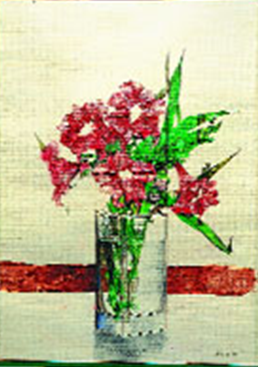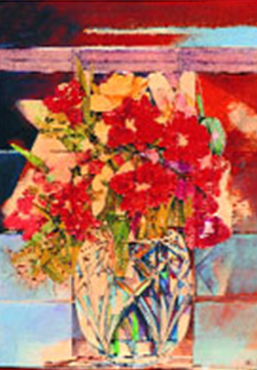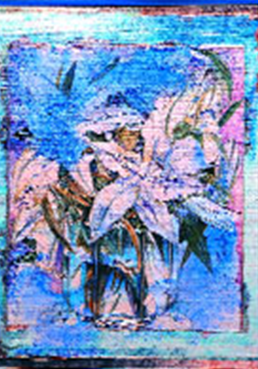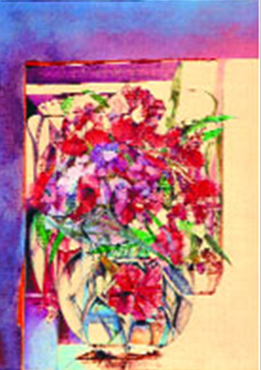Mona Naqsh
This is a collection of articles archived for the excellence of their content. Readers will be able to edit existing articles and post new articles directly |
Mona Naqsh
Floral images in contemporary art
By Salwat Ali
In her third solo exhibition, while Mona Naqsh’s signature imagery is still there, her work emanates greater confidence, writes Salwat Ali
Innocent florals in vibrant colour orchestrations – this exhibition of floral paintings by Mona Naqsh on show at Unicorn Art Gallery in Karachi comes across as a brave effort. She is holding her own in an art milieu which has moved on. The flower is no longer the prime motif in today’s new art genres, mix media and issue based art, so popular with new generation artists. For them representational images of daisies and daffodils are passé. But these ethereal yet earthly symbols of fertility and hope are one of art’s most abiding clichés. Even the most austere and intellectual of painters have found it hard to resist the challenge of capturing on canvas their delicate charms.
Jamil Naqsh’s early work also centralized on floral expression and as a daughter, Mona has merely owned a legacy that was hers for the taking. However, adopting a pre-formed mannerism is as easy as it is challenging. While she can bask in the halo created by Naqsh, as an independent artist she will have to eventually create her own charisma.
Painting sprays, bouquets and bursts of delicate, fine-petalled florals like daises, cowslips and chrysanthemums in sparkling crystal vases has been central to her oeuvre since her maiden solo in 1997. In her third solo today the signature imagery is still there but she is painting with greater confidence. Her lines are stronger, her strokes surer and her chromatic play up, by far her strongest asset, has matured. Mona considers herself a representational painter but her colour rendition is abstract. A mysterious spontaneity that is the hallmark of individuality is apparent in her colour application. Her florals lose impact without the ebb and flow of her tonal intensities. She builds and grades her chromatics with a delightful intuitiveness and if her bouquets appear a trifle contrived her colour spreads are an act of free will.
Stirrings of change or additions in her aesthetic vocabulary are faintly visible in some paintings on show in the gallery. The current collection titled ‘Osseous Blossoming’ references the human musculature as an inspirational source. Scores of muscles stretched across the skeletal framework reminded her of the fine network of intricate branches and stems attached to her floral blooms and she has tried to interweave them into her bouquets. Tentative and cautious her attempts do not come across as definite statements with impact and need to be explored and developed further
Flowers have blossomed profusely throughout art history, next to landscape and figurative art, painting of birds, flowers and animals has occupied a significant place in Asian art, but their easy appeal and lack of dialectical provocation (after all, as Gertrude Stein said, ‘’a rose is a rose is a rose’’) has denied them the ponderous intent that other art forms enjoy. Current art thrives on conceptual twists and some modern artists have played with the floral form as a site of cerebral engagement. Its colors, shapes and metaphorical possibilities have been explored in entirely new terms and in America, such disparate talents as Georgia O’Keeffe and Ellsworth Kelly have been attracted to it. O’Keeffe’s best flower pictures are masterpieces of organic form, metaphors of the unfolding of the inner self. Some of the paintings are brash in their erotic associations, outrageous color contrasts and overblown size; a few even suggest Pop Art.
Toying with size and scale and angles and positions of her main subject can dramatically alter her presentations and break the tedium of stillness. But when artists are conserving and sharpening painting and drawing skills, as Mona is very rightly doing, radical ruptures take a while in coming, but the possibilities are there.
In an art climate increasingly dominated by questioning minds of art school graduates Mona Naqsh, developing under the shadow of her father, is a product of an ustad shagird sensibility. One school of thought emphasizes refinement of skills, the other purports conceptual thinking. Both are necessary components of art making and forward looking artists strike their own balance. In our brief art history, Zubeida Agha is one of the few artists who exploited the flower to advantage in her paintings. Her ‘Yellow Poppies,’ ‘Lotus Melting,’ a number of red flower paintings and bouquet forms reference the flower in many imaginative guises. The flower as a glorious emblem of nature is suffering from neglect and if an artist can resurrect it in meaningful terms then he / she is on fertile ground.





